Financial Ratio Analysis and Investment Appraisal Homework Solution
VerifiedAdded on 2023/06/10
|11
|1621
|352
Homework Assignment
AI Summary
This assignment solution provides a detailed analysis of financial statements and investment appraisal techniques. It includes an income statement, statement of financial position, and calculations for payback period, net present value (NPV), and internal rate of return (IRR). The analysis also covers financial ratios such as gross profit margin, net profit margin, current ratio, and quick ratio, with a comparative assessment between two companies (NS plc and MS plc). The document concludes with a discussion of non-financial factors influencing investment decisions and advantages of the IRR method. Desklib offers a wide range of solved assignments and study resources for students.

AFB
Paraphrase This Document
Need a fresh take? Get an instant paraphrase of this document with our AI Paraphraser
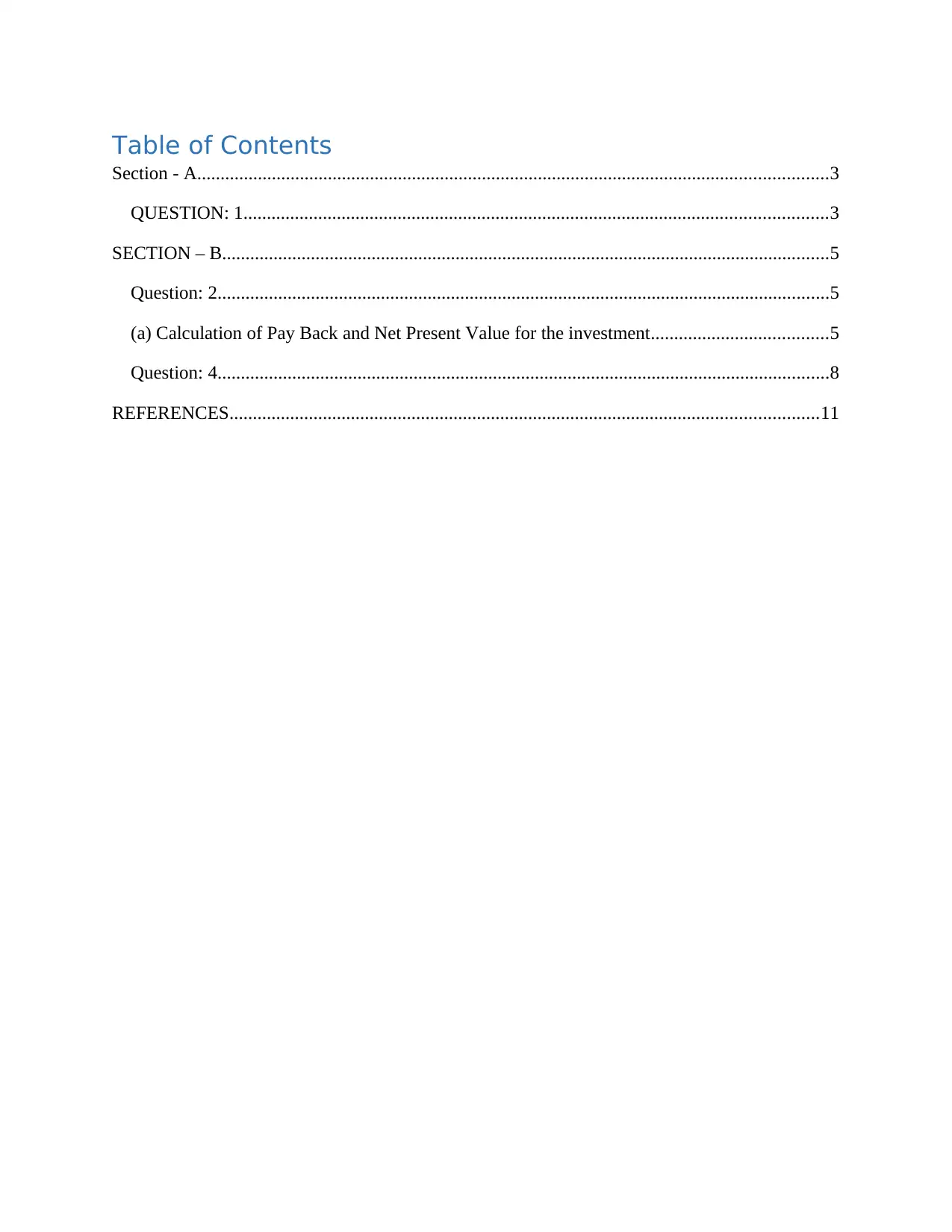
Table of Contents
Section - A.......................................................................................................................................3
QUESTION: 1.............................................................................................................................3
SECTION – B..................................................................................................................................5
Question: 2...................................................................................................................................5
(a) Calculation of Pay Back and Net Present Value for the investment......................................5
Question: 4...................................................................................................................................8
REFERENCES..............................................................................................................................11
Section - A.......................................................................................................................................3
QUESTION: 1.............................................................................................................................3
SECTION – B..................................................................................................................................5
Question: 2...................................................................................................................................5
(a) Calculation of Pay Back and Net Present Value for the investment......................................5
Question: 4...................................................................................................................................8
REFERENCES..............................................................................................................................11
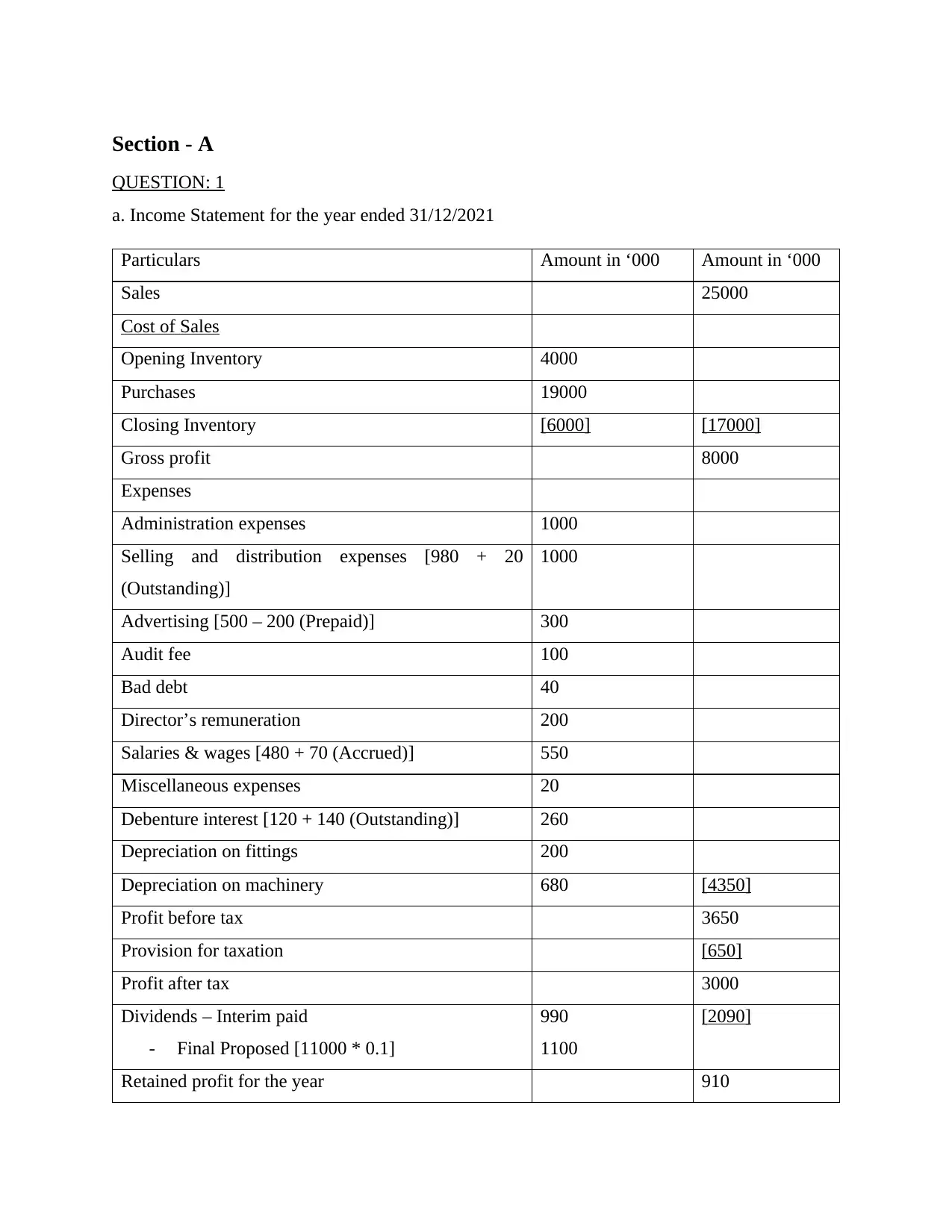
Section - A
QUESTION: 1
a. Income Statement for the year ended 31/12/2021
Particulars Amount in ‘000 Amount in ‘000
Sales 25000
Cost of Sales
Opening Inventory 4000
Purchases 19000
Closing Inventory [6000] [17000]
Gross profit 8000
Expenses
Administration expenses 1000
Selling and distribution expenses [980 + 20
(Outstanding)]
1000
Advertising [500 – 200 (Prepaid)] 300
Audit fee 100
Bad debt 40
Director’s remuneration 200
Salaries & wages [480 + 70 (Accrued)] 550
Miscellaneous expenses 20
Debenture interest [120 + 140 (Outstanding)] 260
Depreciation on fittings 200
Depreciation on machinery 680 [4350]
Profit before tax 3650
Provision for taxation [650]
Profit after tax 3000
Dividends – Interim paid
- Final Proposed [11000 * 0.1]
990
1100
[2090]
Retained profit for the year 910
QUESTION: 1
a. Income Statement for the year ended 31/12/2021
Particulars Amount in ‘000 Amount in ‘000
Sales 25000
Cost of Sales
Opening Inventory 4000
Purchases 19000
Closing Inventory [6000] [17000]
Gross profit 8000
Expenses
Administration expenses 1000
Selling and distribution expenses [980 + 20
(Outstanding)]
1000
Advertising [500 – 200 (Prepaid)] 300
Audit fee 100
Bad debt 40
Director’s remuneration 200
Salaries & wages [480 + 70 (Accrued)] 550
Miscellaneous expenses 20
Debenture interest [120 + 140 (Outstanding)] 260
Depreciation on fittings 200
Depreciation on machinery 680 [4350]
Profit before tax 3650
Provision for taxation [650]
Profit after tax 3000
Dividends – Interim paid
- Final Proposed [11000 * 0.1]
990
1100
[2090]
Retained profit for the year 910
⊘ This is a preview!⊘
Do you want full access?
Subscribe today to unlock all pages.

Trusted by 1+ million students worldwide
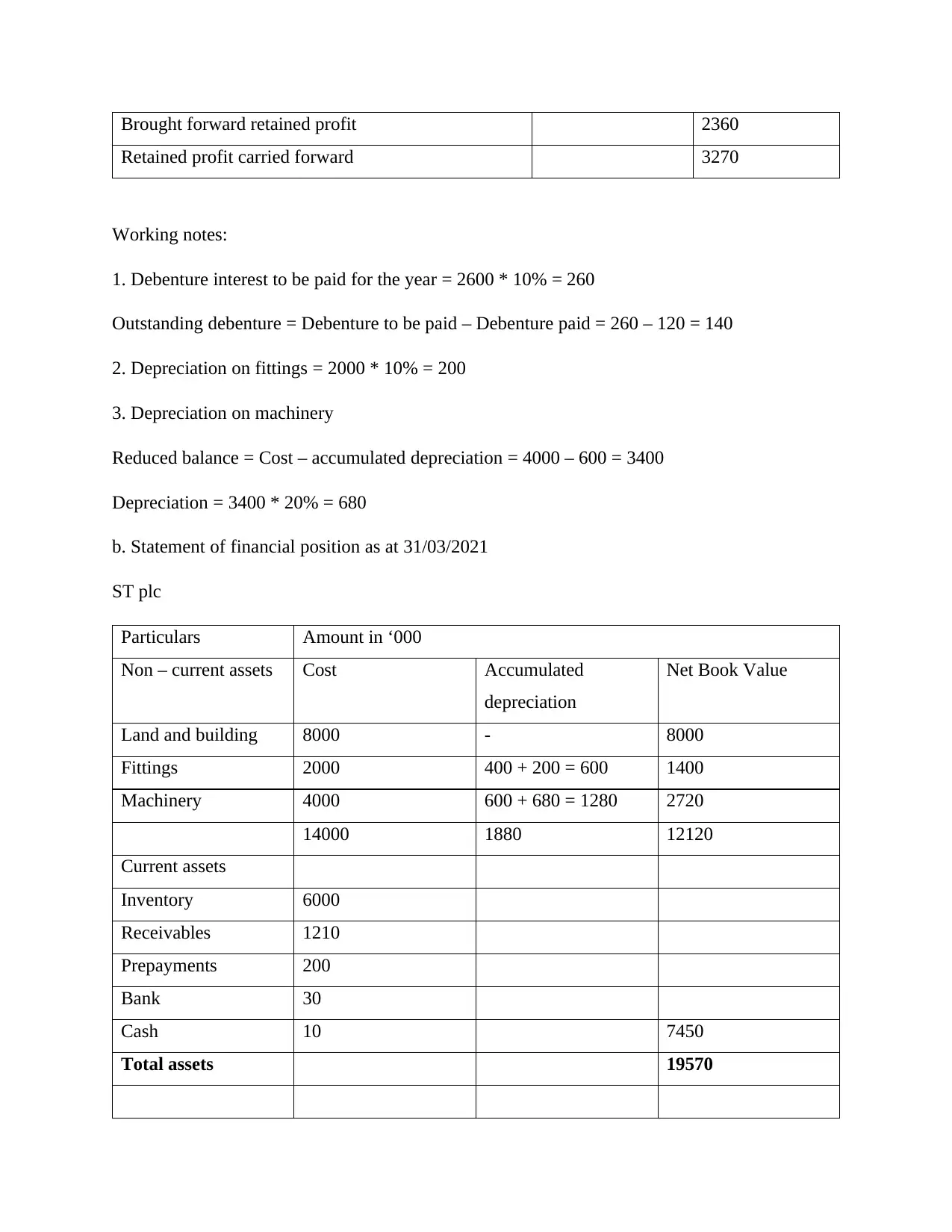
Brought forward retained profit 2360
Retained profit carried forward 3270
Working notes:
1. Debenture interest to be paid for the year = 2600 * 10% = 260
Outstanding debenture = Debenture to be paid – Debenture paid = 260 – 120 = 140
2. Depreciation on fittings = 2000 * 10% = 200
3. Depreciation on machinery
Reduced balance = Cost – accumulated depreciation = 4000 – 600 = 3400
Depreciation = 3400 * 20% = 680
b. Statement of financial position as at 31/03/2021
ST plc
Particulars Amount in ‘000
Non – current assets Cost Accumulated
depreciation
Net Book Value
Land and building 8000 - 8000
Fittings 2000 400 + 200 = 600 1400
Machinery 4000 600 + 680 = 1280 2720
14000 1880 12120
Current assets
Inventory 6000
Receivables 1210
Prepayments 200
Bank 30
Cash 10 7450
Total assets 19570
Retained profit carried forward 3270
Working notes:
1. Debenture interest to be paid for the year = 2600 * 10% = 260
Outstanding debenture = Debenture to be paid – Debenture paid = 260 – 120 = 140
2. Depreciation on fittings = 2000 * 10% = 200
3. Depreciation on machinery
Reduced balance = Cost – accumulated depreciation = 4000 – 600 = 3400
Depreciation = 3400 * 20% = 680
b. Statement of financial position as at 31/03/2021
ST plc
Particulars Amount in ‘000
Non – current assets Cost Accumulated
depreciation
Net Book Value
Land and building 8000 - 8000
Fittings 2000 400 + 200 = 600 1400
Machinery 4000 600 + 680 = 1280 2720
14000 1880 12120
Current assets
Inventory 6000
Receivables 1210
Prepayments 200
Bank 30
Cash 10 7450
Total assets 19570
Paraphrase This Document
Need a fresh take? Get an instant paraphrase of this document with our AI Paraphraser
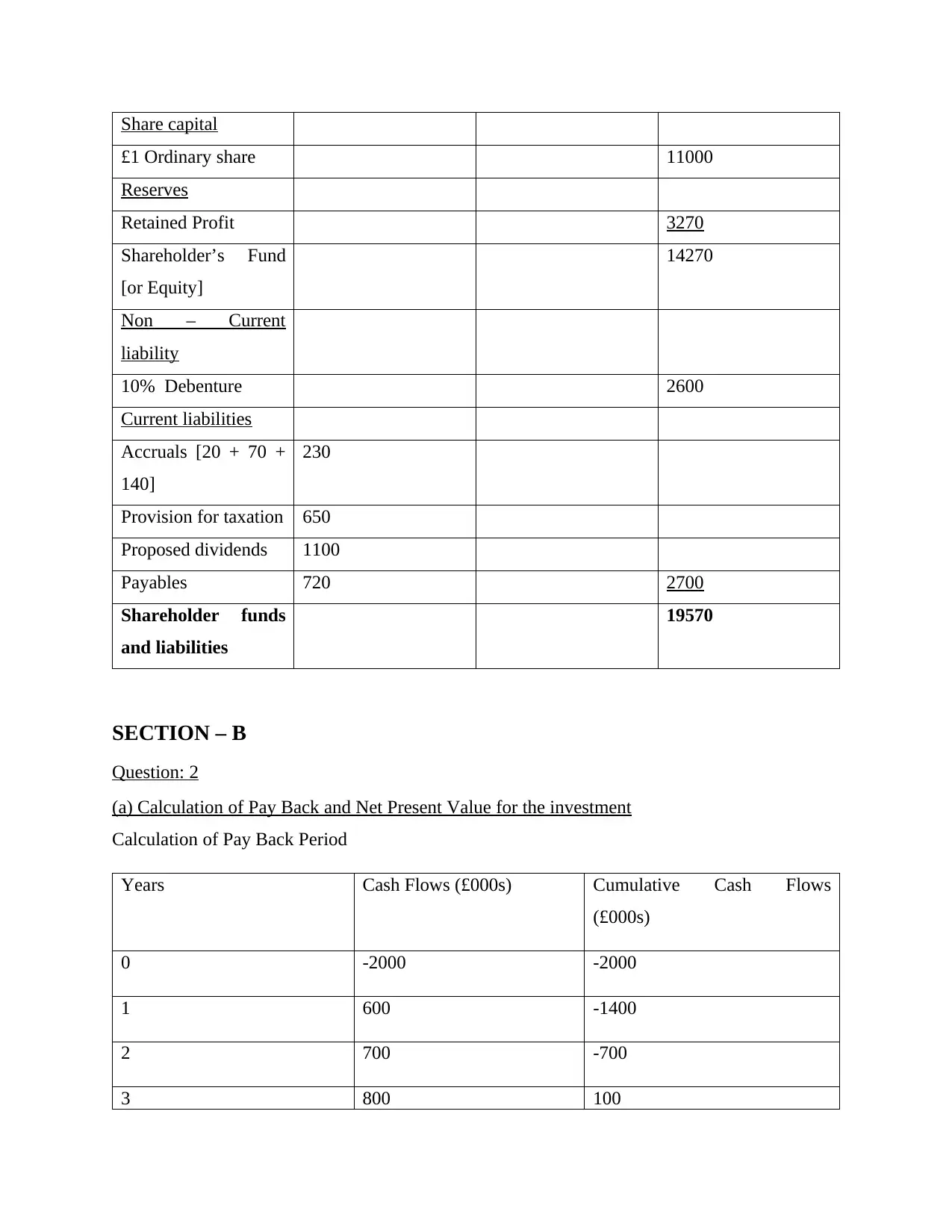
Share capital
£1 Ordinary share 11000
Reserves
Retained Profit 3270
Shareholder’s Fund
[or Equity]
14270
Non – Current
liability
10% Debenture 2600
Current liabilities
Accruals [20 + 70 +
140]
230
Provision for taxation 650
Proposed dividends 1100
Payables 720 2700
Shareholder funds
and liabilities
19570
SECTION – B
Question: 2
(a) Calculation of Pay Back and Net Present Value for the investment
Calculation of Pay Back Period
Years Cash Flows (£000s) Cumulative Cash Flows
(£000s)
0 -2000 -2000
1 600 -1400
2 700 -700
3 800 100
£1 Ordinary share 11000
Reserves
Retained Profit 3270
Shareholder’s Fund
[or Equity]
14270
Non – Current
liability
10% Debenture 2600
Current liabilities
Accruals [20 + 70 +
140]
230
Provision for taxation 650
Proposed dividends 1100
Payables 720 2700
Shareholder funds
and liabilities
19570
SECTION – B
Question: 2
(a) Calculation of Pay Back and Net Present Value for the investment
Calculation of Pay Back Period
Years Cash Flows (£000s) Cumulative Cash Flows
(£000s)
0 -2000 -2000
1 600 -1400
2 700 -700
3 800 100
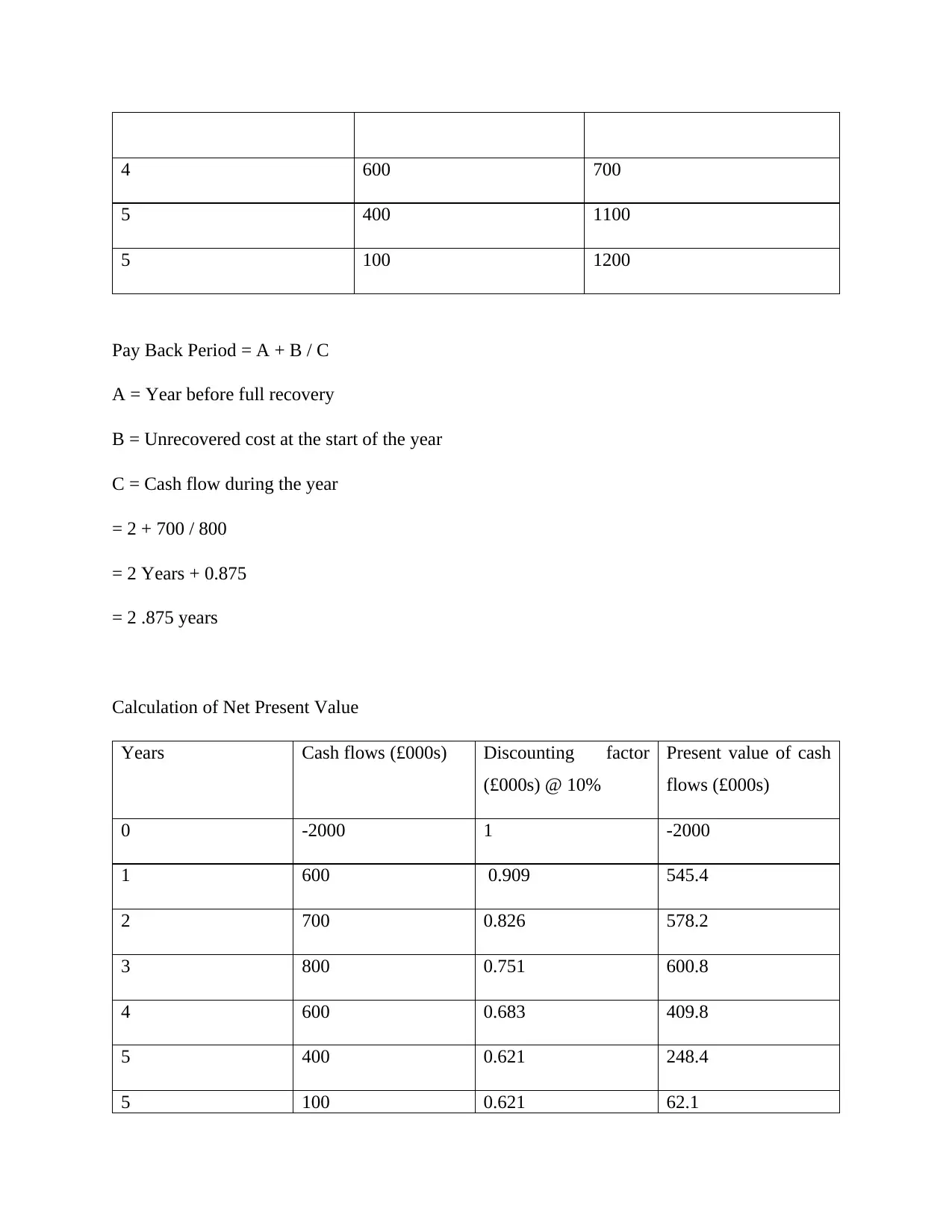
4 600 700
5 400 1100
5 100 1200
Pay Back Period = A + B / C
A = Year before full recovery
B = Unrecovered cost at the start of the year
C = Cash flow during the year
= 2 + 700 / 800
= 2 Years + 0.875
= 2 .875 years
Calculation of Net Present Value
Years Cash flows (£000s) Discounting factor
(£000s) @ 10%
Present value of cash
flows (£000s)
0 -2000 1 -2000
1 600 0.909 545.4
2 700 0.826 578.2
3 800 0.751 600.8
4 600 0.683 409.8
5 400 0.621 248.4
5 100 0.621 62.1
5 400 1100
5 100 1200
Pay Back Period = A + B / C
A = Year before full recovery
B = Unrecovered cost at the start of the year
C = Cash flow during the year
= 2 + 700 / 800
= 2 Years + 0.875
= 2 .875 years
Calculation of Net Present Value
Years Cash flows (£000s) Discounting factor
(£000s) @ 10%
Present value of cash
flows (£000s)
0 -2000 1 -2000
1 600 0.909 545.4
2 700 0.826 578.2
3 800 0.751 600.8
4 600 0.683 409.8
5 400 0.621 248.4
5 100 0.621 62.1
⊘ This is a preview!⊘
Do you want full access?
Subscribe today to unlock all pages.

Trusted by 1+ million students worldwide

Net Present Value = Present value of Cash inflow – Present value of
cash outflow or initial investment
444.7
b. Advising K Plc with regard to the investment proposal
The payback period indicates the time that an investment took to bring back the initial amount of
investment made. In the given scenario, the payback period comes out as 2.8 or 3 years
approximately which is considered to be acceptable duration within which the initial cost
incurred for investment would get recovered. Furthermore, the net present value of the
investment in machinery comes out as positive which indicates that the present value of
future cash inflows are more than the present of cash outflows and thus the investment made in
machinery would be profitable for K plc. In other words, positive NPV indicates that the
projected earnings from the investment is higher than the projected cost of the investment.
c. Non – financial factors affecting the decision making
Good practices and industry standards to be fulfilled by the business organization which
has been established by the law of the nation.
Requirements to be fulfilled of present and future legislations.
Technological developments affecting the business sustainability and customer
expectations or satisfaction level.
Relationship with customers and suppliers of the business affecting viability of the
investment.
Dealing with and anticipating future threats from competition. For instance, protection to
intellectual property rights against the prevailing competition (Alabdullah and Maryanti,
2021).
d. IRR or Internal rate of return is one of the technique of appraising the available investment
proposals. With the help of this technique, management of the business are able to decide
whether they should go for making the investment or not by determining its profitability through
IRR method. The project with greater IRR than the cost of capital is acceptable and in case of
cash outflow or initial investment
444.7
b. Advising K Plc with regard to the investment proposal
The payback period indicates the time that an investment took to bring back the initial amount of
investment made. In the given scenario, the payback period comes out as 2.8 or 3 years
approximately which is considered to be acceptable duration within which the initial cost
incurred for investment would get recovered. Furthermore, the net present value of the
investment in machinery comes out as positive which indicates that the present value of
future cash inflows are more than the present of cash outflows and thus the investment made in
machinery would be profitable for K plc. In other words, positive NPV indicates that the
projected earnings from the investment is higher than the projected cost of the investment.
c. Non – financial factors affecting the decision making
Good practices and industry standards to be fulfilled by the business organization which
has been established by the law of the nation.
Requirements to be fulfilled of present and future legislations.
Technological developments affecting the business sustainability and customer
expectations or satisfaction level.
Relationship with customers and suppliers of the business affecting viability of the
investment.
Dealing with and anticipating future threats from competition. For instance, protection to
intellectual property rights against the prevailing competition (Alabdullah and Maryanti,
2021).
d. IRR or Internal rate of return is one of the technique of appraising the available investment
proposals. With the help of this technique, management of the business are able to decide
whether they should go for making the investment or not by determining its profitability through
IRR method. The project with greater IRR than the cost of capital is acceptable and in case of
Paraphrase This Document
Need a fresh take? Get an instant paraphrase of this document with our AI Paraphraser
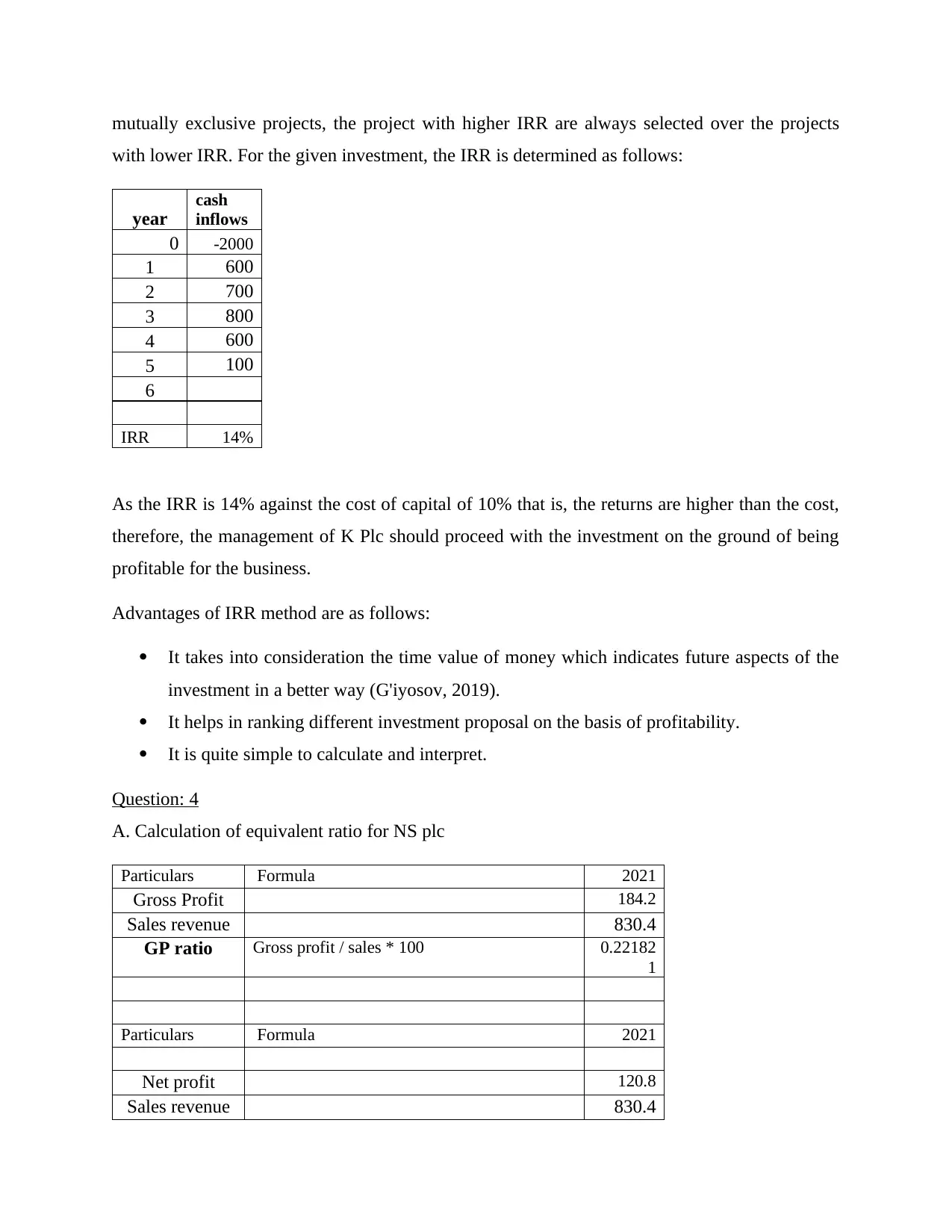
mutually exclusive projects, the project with higher IRR are always selected over the projects
with lower IRR. For the given investment, the IRR is determined as follows:
year
cash
inflows
0 -2000
1 600
2 700
3 800
4 600
5 100
6
IRR 14%
As the IRR is 14% against the cost of capital of 10% that is, the returns are higher than the cost,
therefore, the management of K Plc should proceed with the investment on the ground of being
profitable for the business.
Advantages of IRR method are as follows:
It takes into consideration the time value of money which indicates future aspects of the
investment in a better way (G'iyosov, 2019).
It helps in ranking different investment proposal on the basis of profitability.
It is quite simple to calculate and interpret.
Question: 4
A. Calculation of equivalent ratio for NS plc
Particulars Formula 2021
Gross Profit 184.2
Sales revenue 830.4
GP ratio Gross profit / sales * 100 0.22182
1
Particulars Formula 2021
Net profit 120.8
Sales revenue 830.4
with lower IRR. For the given investment, the IRR is determined as follows:
year
cash
inflows
0 -2000
1 600
2 700
3 800
4 600
5 100
6
IRR 14%
As the IRR is 14% against the cost of capital of 10% that is, the returns are higher than the cost,
therefore, the management of K Plc should proceed with the investment on the ground of being
profitable for the business.
Advantages of IRR method are as follows:
It takes into consideration the time value of money which indicates future aspects of the
investment in a better way (G'iyosov, 2019).
It helps in ranking different investment proposal on the basis of profitability.
It is quite simple to calculate and interpret.
Question: 4
A. Calculation of equivalent ratio for NS plc
Particulars Formula 2021
Gross Profit 184.2
Sales revenue 830.4
GP ratio Gross profit / sales * 100 0.22182
1
Particulars Formula 2021
Net profit 120.8
Sales revenue 830.4
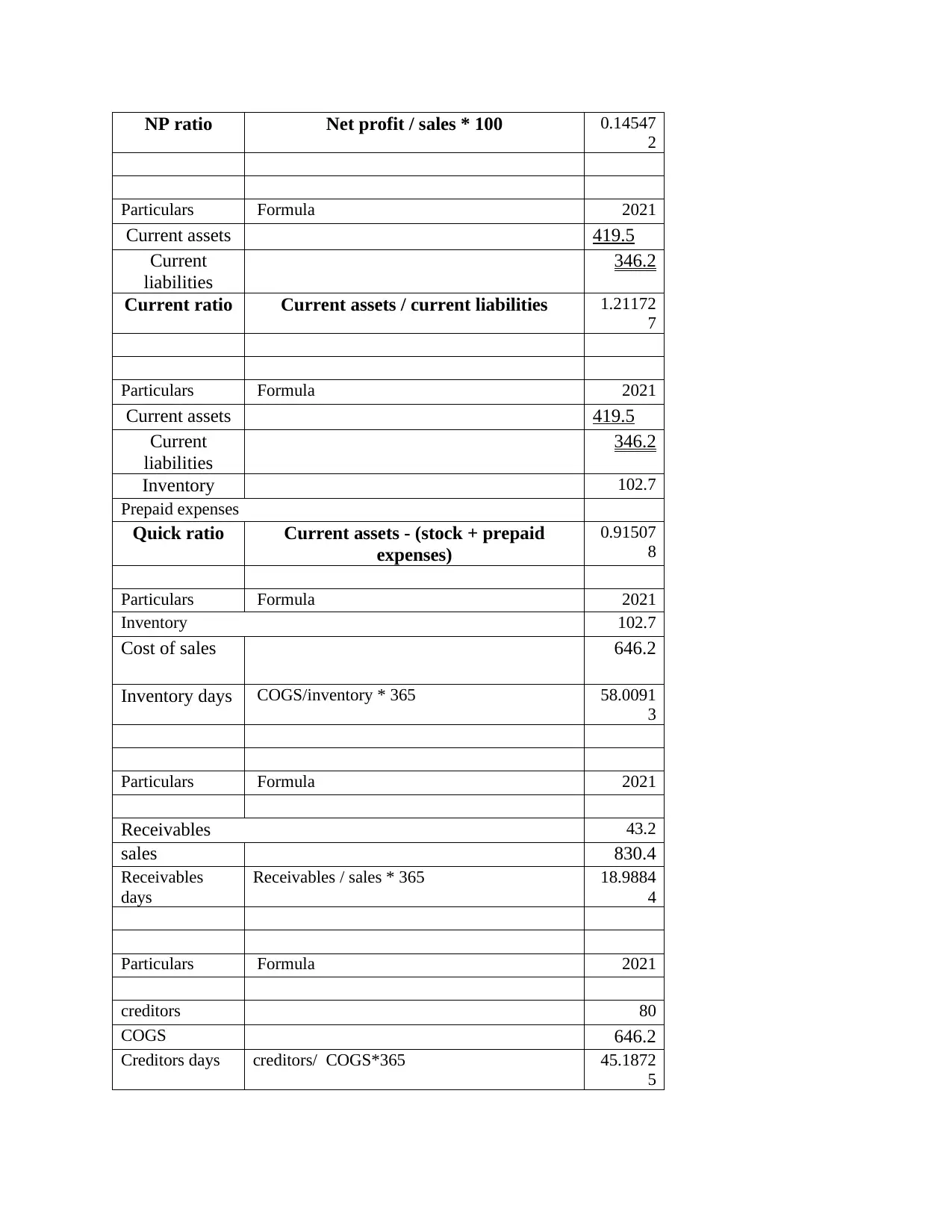
NP ratio Net profit / sales * 100 0.14547
2
Particulars Formula 2021
Current assets 419.5
Current
liabilities
346.2
Current ratio Current assets / current liabilities 1.21172
7
Particulars Formula 2021
Current assets 419.5
Current
liabilities
346.2
Inventory 102.7
Prepaid expenses
Quick ratio Current assets - (stock + prepaid
expenses)
0.91507
8
Particulars Formula 2021
Inventory 102.7
Cost of sales 646.2
Inventory days COGS/inventory * 365 58.0091
3
Particulars Formula 2021
Receivables 43.2
sales 830.4
Receivables
days
Receivables / sales * 365 18.9884
4
Particulars Formula 2021
creditors 80
COGS 646.2
Creditors days creditors/ COGS*365 45.1872
5
2
Particulars Formula 2021
Current assets 419.5
Current
liabilities
346.2
Current ratio Current assets / current liabilities 1.21172
7
Particulars Formula 2021
Current assets 419.5
Current
liabilities
346.2
Inventory 102.7
Prepaid expenses
Quick ratio Current assets - (stock + prepaid
expenses)
0.91507
8
Particulars Formula 2021
Inventory 102.7
Cost of sales 646.2
Inventory days COGS/inventory * 365 58.0091
3
Particulars Formula 2021
Receivables 43.2
sales 830.4
Receivables
days
Receivables / sales * 365 18.9884
4
Particulars Formula 2021
creditors 80
COGS 646.2
Creditors days creditors/ COGS*365 45.1872
5
⊘ This is a preview!⊘
Do you want full access?
Subscribe today to unlock all pages.

Trusted by 1+ million students worldwide
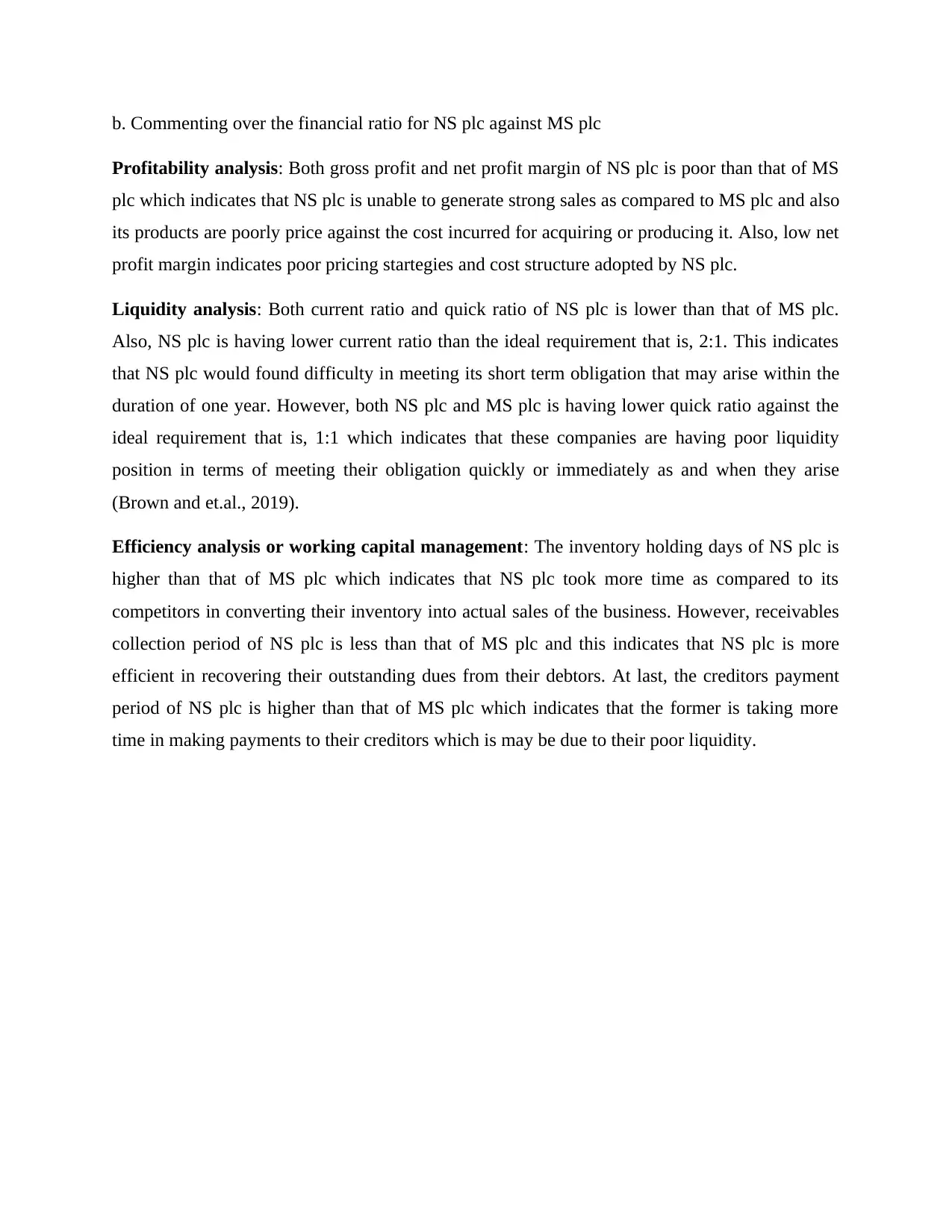
b. Commenting over the financial ratio for NS plc against MS plc
Profitability analysis: Both gross profit and net profit margin of NS plc is poor than that of MS
plc which indicates that NS plc is unable to generate strong sales as compared to MS plc and also
its products are poorly price against the cost incurred for acquiring or producing it. Also, low net
profit margin indicates poor pricing startegies and cost structure adopted by NS plc.
Liquidity analysis: Both current ratio and quick ratio of NS plc is lower than that of MS plc.
Also, NS plc is having lower current ratio than the ideal requirement that is, 2:1. This indicates
that NS plc would found difficulty in meeting its short term obligation that may arise within the
duration of one year. However, both NS plc and MS plc is having lower quick ratio against the
ideal requirement that is, 1:1 which indicates that these companies are having poor liquidity
position in terms of meeting their obligation quickly or immediately as and when they arise
(Brown and et.al., 2019).
Efficiency analysis or working capital management: The inventory holding days of NS plc is
higher than that of MS plc which indicates that NS plc took more time as compared to its
competitors in converting their inventory into actual sales of the business. However, receivables
collection period of NS plc is less than that of MS plc and this indicates that NS plc is more
efficient in recovering their outstanding dues from their debtors. At last, the creditors payment
period of NS plc is higher than that of MS plc which indicates that the former is taking more
time in making payments to their creditors which is may be due to their poor liquidity.
Profitability analysis: Both gross profit and net profit margin of NS plc is poor than that of MS
plc which indicates that NS plc is unable to generate strong sales as compared to MS plc and also
its products are poorly price against the cost incurred for acquiring or producing it. Also, low net
profit margin indicates poor pricing startegies and cost structure adopted by NS plc.
Liquidity analysis: Both current ratio and quick ratio of NS plc is lower than that of MS plc.
Also, NS plc is having lower current ratio than the ideal requirement that is, 2:1. This indicates
that NS plc would found difficulty in meeting its short term obligation that may arise within the
duration of one year. However, both NS plc and MS plc is having lower quick ratio against the
ideal requirement that is, 1:1 which indicates that these companies are having poor liquidity
position in terms of meeting their obligation quickly or immediately as and when they arise
(Brown and et.al., 2019).
Efficiency analysis or working capital management: The inventory holding days of NS plc is
higher than that of MS plc which indicates that NS plc took more time as compared to its
competitors in converting their inventory into actual sales of the business. However, receivables
collection period of NS plc is less than that of MS plc and this indicates that NS plc is more
efficient in recovering their outstanding dues from their debtors. At last, the creditors payment
period of NS plc is higher than that of MS plc which indicates that the former is taking more
time in making payments to their creditors which is may be due to their poor liquidity.
Paraphrase This Document
Need a fresh take? Get an instant paraphrase of this document with our AI Paraphraser

REFERENCES
Brown, C., and et.al., 2019. Accounting for business adaptations in economic disruption
models. Journal of Infrastructure Systems, 25(1), p.04019001.
G'iyosov, I. K., 2019. THE THEORICAL FEATURES OF THE ORGANIZATION OF THE
STRATEGIC MANAGEMENT ACCOUNTING IN BUSINESS. Theoretical & Applied
Science, (9), pp.260-266.
Alabdullah, T. T. and Maryanti, E., 2021. Internal Control Mechanisms in Accounting,
Management, and Economy: A review of the Literature and Suggestions of New
Investigations. International Journal of Business and Management Invention, 10(9).
Brown, C., and et.al., 2019. Accounting for business adaptations in economic disruption
models. Journal of Infrastructure Systems, 25(1), p.04019001.
G'iyosov, I. K., 2019. THE THEORICAL FEATURES OF THE ORGANIZATION OF THE
STRATEGIC MANAGEMENT ACCOUNTING IN BUSINESS. Theoretical & Applied
Science, (9), pp.260-266.
Alabdullah, T. T. and Maryanti, E., 2021. Internal Control Mechanisms in Accounting,
Management, and Economy: A review of the Literature and Suggestions of New
Investigations. International Journal of Business and Management Invention, 10(9).
1 out of 11
Related Documents
Your All-in-One AI-Powered Toolkit for Academic Success.
+13062052269
info@desklib.com
Available 24*7 on WhatsApp / Email
![[object Object]](/_next/static/media/star-bottom.7253800d.svg)
Unlock your academic potential
Copyright © 2020–2025 A2Z Services. All Rights Reserved. Developed and managed by ZUCOL.


